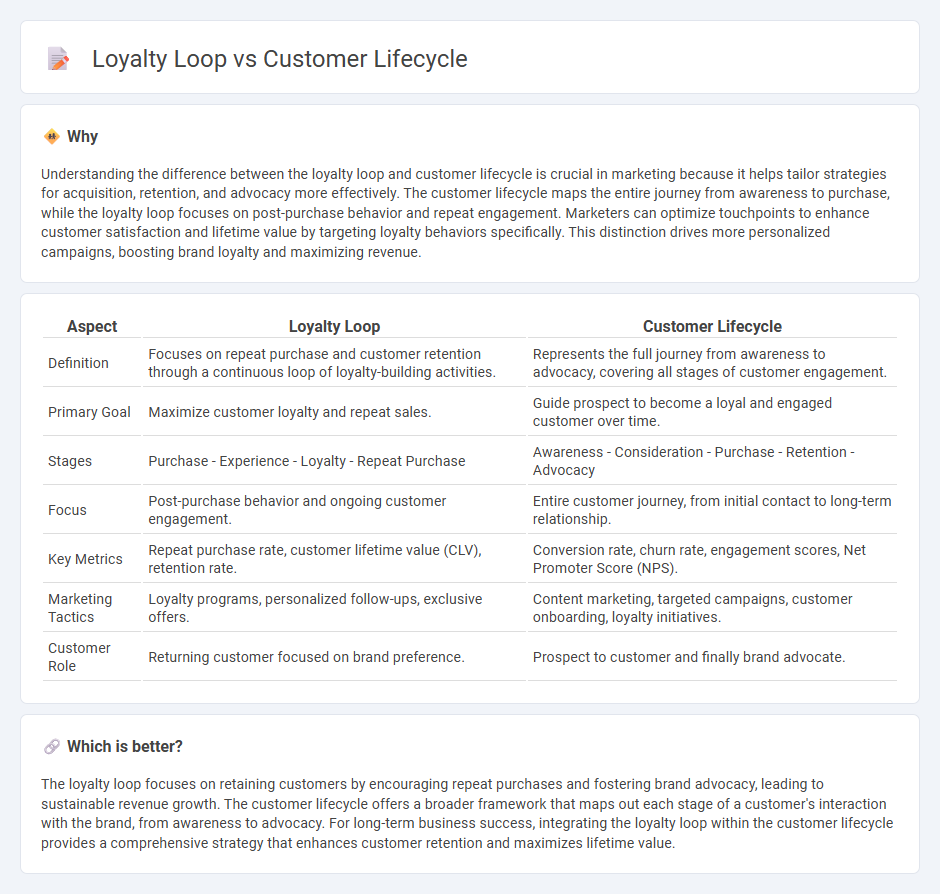
The loyalty loop focuses on retaining customers by encouraging repeat purchases and fostering long-term brand loyalty, while the customer lifecycle maps the entire journey from awareness to advocacy. Understanding these models helps businesses optimize marketing strategies for engagement and retention. Explore deeper insights into how these frameworks transform customer relationships and drive growth.
Why it is important
Understanding the difference between the loyalty loop and customer lifecycle is crucial in marketing because it helps tailor strategies for acquisition, retention, and advocacy more effectively. The customer lifecycle maps the entire journey from awareness to purchase, while the loyalty loop focuses on post-purchase behavior and repeat engagement. Marketers can optimize touchpoints to enhance customer satisfaction and lifetime value by targeting loyalty behaviors specifically. This distinction drives more personalized campaigns, boosting brand loyalty and maximizing revenue.
Comparison Table
| Aspect | Loyalty Loop | Customer Lifecycle |
|---|---|---|
| Definition | Focuses on repeat purchase and customer retention through a continuous loop of loyalty-building activities. | Represents the full journey from awareness to advocacy, covering all stages of customer engagement. |
| Primary Goal | Maximize customer loyalty and repeat sales. | Guide prospect to become a loyal and engaged customer over time. |
| Stages | Purchase - Experience - Loyalty - Repeat Purchase | Awareness - Consideration - Purchase - Retention - Advocacy |
| Focus | Post-purchase behavior and ongoing customer engagement. | Entire customer journey, from initial contact to long-term relationship. |
| Key Metrics | Repeat purchase rate, customer lifetime value (CLV), retention rate. | Conversion rate, churn rate, engagement scores, Net Promoter Score (NPS). |
| Marketing Tactics | Loyalty programs, personalized follow-ups, exclusive offers. | Content marketing, targeted campaigns, customer onboarding, loyalty initiatives. |
| Customer Role | Returning customer focused on brand preference. | Prospect to customer and finally brand advocate. |
Which is better?
The loyalty loop focuses on retaining customers by encouraging repeat purchases and fostering brand advocacy, leading to sustainable revenue growth. The customer lifecycle offers a broader framework that maps out each stage of a customer's interaction with the brand, from awareness to advocacy. For long-term business success, integrating the loyalty loop within the customer lifecycle provides a comprehensive strategy that enhances customer retention and maximizes lifetime value.
Connection
The loyalty loop and customer lifecycle are connected through their focus on maximizing customer retention and value over time. The customer lifecycle outlines stages from awareness to purchase and loyalty, while the loyalty loop emphasizes ongoing engagement after purchase to foster repeat business and advocacy. By integrating loyalty loop strategies into the customer lifecycle, businesses enhance customer experiences, increase lifetime value, and drive sustainable growth.
Key Terms
Customer Lifecycle:
The customer lifecycle encompasses the entire journey from brand awareness and consideration through purchase and post-purchase engagement, emphasizing nurturing relationships at each stage to maximize customer value. Key phases include acquisition, activation, retention, and advocacy, with strategies tailored to drive repeat business and long-term satisfaction. Explore how optimizing each lifecycle phase can boost customer lifetime value and transform one-time buyers into loyal brand advocates.
Awareness
The customer lifecycle's Awareness stage involves attracting potential buyers through targeted marketing, brand visibility, and engaging content, establishing the first connection with the audience. In contrast, the Loyalty Loop emphasizes re-engagement of existing customers by maintaining brand relevance and encouraging repeat interactions. Explore more to understand how Awareness strategies differ and complement each model for effective customer retention.
Consideration
During the Consideration stage in the customer lifecycle, potential buyers evaluate various products or services, comparing features, benefits, and prices to determine the best fit for their needs. In contrast, the Loyalty Loop emphasizes reinforcing positive experiences and trust to encourage repeat purchases and reduce the consideration phase for returning customers. Explore more insights on optimizing customer engagement at different stages for improved retention.
Source and External Links
Customer lifecycle management: Definition, strategy, + 5 stages - Defines the customer lifecycle as five stages: awareness, engagement, conversion, retention, and loyalty, outlining how customers progress from first learning about a company to becoming loyal patrons.
Customer lifecycle stages: management, tips & software [2025] - Presents the five key stages as reach, acquisition, conversion, retention, and loyalty, emphasizing that each stage offers unique challenges and opportunities for businesses to engage and retain customers.
What is the customer lifecycle? Definition, stages, and tips - Delighted - Describes the customer lifecycle as awareness, consideration, purchase, retention, and advocacy, highlighting that the process is ongoing and customers may cycle in and out over time.
 dowidth.com
dowidth.com